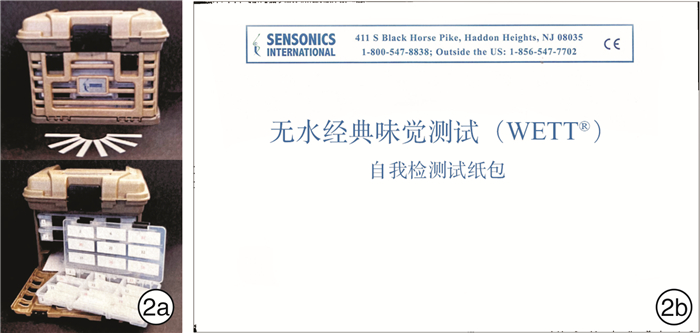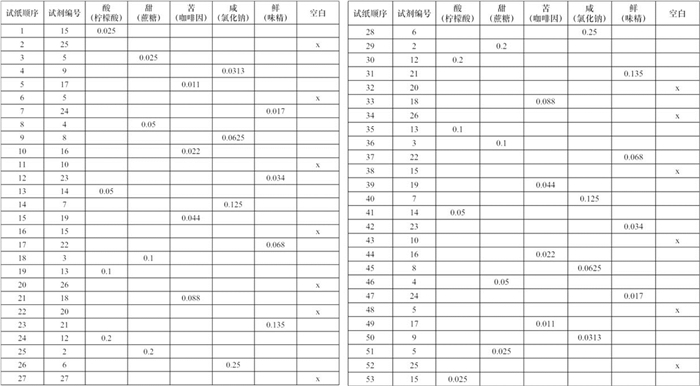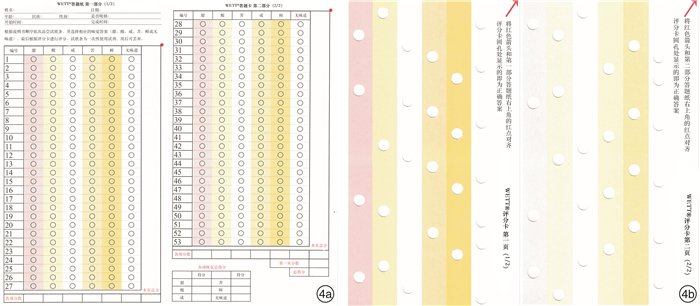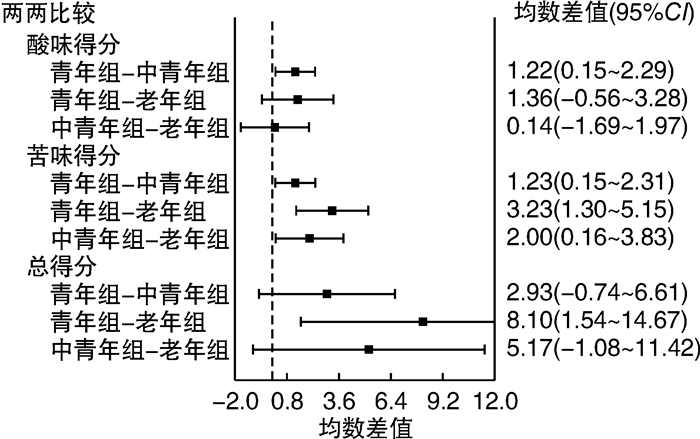The application of waterless empirical taste test(WETT®) in 159 Chinese healthy subjects
-
摘要: 目的 使用一种简便、灵活的无水经验味觉测试法(WETT®)测试健康中国人群的味觉功能水平与年龄、性别的相关性,为临床味觉功能评估提供科学依据。方法 严格依据纳入和排除标准,共招募到159名自评味觉功能正常的受试者,使用53条含有无水味觉试剂的WETT®试纸条,检测受试者的酸、甜、苦、咸、鲜5种基本味觉功能水平。采用SAS 9.4软件进行统计学分析。结果 人群的味觉总得分为(35.00±8.94)分,平均测试时间为(21.61±7.80) min。各年龄组味觉测试总得分随年龄增加呈下降趋势,青年组、中青年组和老年组分别为(37.41±8.12)分、(34.48±9.04)分和(29.31±8.64)分,味觉总得分与年龄呈负相关性(r=-0.335,P<0.05)。在各种味觉得分中,不同年龄组的酸味和苦味差异有统计学意义(P酸味=0.019,P苦味<0.001)。女性的味觉测试总得分较男性高,差异有统计学意义[女:(36.53±8.72)分,男:(32.93±8.87)分,P=0.012]。单项味觉得分间有显著相关性,其中鲜味与总分的相关性最强(r鲜/总=0.700,P<0.05)。结论 WETT®作为一种简便灵活的无水经验味觉测试可应用在健康中国人群中。性别和年龄是影响味觉功能的主要因素。Abstract: Objective This study examined the influences of age and gender on the taste function of a sizable sample of healthy Chinese subjects using the Waterless Empirical Taste Test(WETT®), and provided scientific evidences for taste evaluation in clinic.Methods A total of 159 subjects were tested based on strict inclusion and exclusion criteria. The 53 stimuli strips, presented on monomer cellulose pads, were designed to test 5 basic taste functions including sour, sweet, bitter, salty and umami of all subjects. The analysis was computed in SAS 9.4 statistical software.Results The total taste score of the subjects was 35.00±8.94; the average test administration time was(21.61±7.80) min. The total test scores decreased across age categories(young group: 37.41±8.12, middle-aged group: 34.48±9.04, elderly group: 29.31±8.64), the correlation coefficient between the total test scores and age was r=-0.335, P < 0.05. There were significant differences in sour and bitter scores among different age groups(Psour=0.019, Pbitter < 0.001). Overall, women outperformed men on the total test([36.53±8.72]vs[32.93±8.87], P=0.012). There were correlations among individual taste of scores, and the correlation coefficient between umami and total score was the strongest(rumami/total=0.700, P < 0.05).Conclusion This study demonstrated that a simple self-administered taste test, the WETT®, could be applied to Chinese healthy people. Age and gender-effects are the main factors which affect gustatory function.
-
Key words:
- waterless empirical taste test /
- gender /
- age
-

-
表 1 研究对象基本特征分布
一般特征 总人群(n=159) 性别 P值 男性(n=68) 女性(n=91) 年龄/岁 37.69±16.48 37.16±17.19 38.09±16.02 0.832 吸烟/例(%) 否 126(79.25) 43(63.24) 83(91.21) <0.01 是 33(20.75) 25(36.76) 8(8.79) 年龄分组/例(%) 青年组 51(32.08) 25(36.76) 26(28.57) 中青年组 95(59.75) 37(54.41) 58(63.74) 0.486 老年组 13(8.18) 6(8.82) (7.69) 表 2 WETT®测试各项得分与年龄之间的相关性
项目 年龄 甜味 酸味 咸味 苦味 鲜味 无味道 总得分 年龄 1.000 甜味 -0.097 1.000 酸味 -0.285 0.1751) 1.000 咸味 0.031 0.038 0.134 1.000 苦味 -0.3531) 0.3611) 0.3881) 0.2181) 1.000 鲜味 -0.1521) 0.143 0.4671) 0.4301) 0.3561) 1.000 无味道 -0.119 0.2971) 0.2411) 0.1441) 0.2271) 0.1601) 1.000 总得分 -0.3351) 0.4811) 0.6791) 0.4831) 0.6861) 0.7001) 0.4731) 1.000 1)P<0.05。 表 3 味觉功能水平随年龄的变化趋势
分,X±S 项目 总人群 青年组(n=51) 中青年组(n=95) 老年组(n=13) F值 P值 酸味 4.91±2.60 5.75±2.31 4.53±2.63 4.38±2.93 4.07 0.019 甜味 5.81±2.01 5.88±1.90 5.86±1.99 5.08±2.53 0.93 0.397 苦味 4.75±2.69 5.76±2.15 4.54±2.79 2.54±2.26 9.15 <0.001 咸味 5.49±2.20 5.18±2.50 5.76±2.00 4.77±2.13 1.95 0.146 鲜味 3.32±2.54 3.71±2.94 3.21±2.37 2.62±1.98 1.18 0.311 无味道 10.91±2.21 11.06±1.91 11.01±2.25 9.54±2.70 2.77 0.066 总得分 35.00±8.94 37.41±8.12 34.48±9.04 29.31±8.64 4.88 0.009 表 4 不同性别人群的味觉测试得分
分,X±S 项目 性别 P值 男性 女性 酸味 4.65±2.76 5.10±2.48 0.354 甜味 5.78±2.13 5.82±1.93 0.930 苦味 4.30±2.83 5.08±2.54 0.128 咸味 5.03±2.34 5.84±2.03 0.029 鲜味 2.63±2.46 3.84±2.49 0.002 无味道 10.65±2.22 11.10±2.20 0.174 表 5 味觉测试总得分与性别的关系
性别 例数 总得分 模型1a) 模型2b) 估计值 F值 P值 估计值 F值 P值 男性 68 32.93±8.87 参照组 参照组 女性 91 36.53±8.72 3.602 6.490 0.012 2.716 4.740 0.010 注:a)模型1仅考虑性别与WETT®测试总得分的关联;b)模型2进一步考虑研究对象当前的吸烟状况。 表 6 单项味觉得分之间的相关性分析
项目(分) 甜味 酸味 咸味 苦味 鲜味 无味道 总分 甜味 1.000 酸味 0.1751) 1.000 咸味 0.038 0.134 1.000 苦味 0.3612) 0.3882) 0.2181) 1.000 鲜味 0.143 0.4672) 0.4302) 0.3562) 1.000 无味道 0.2972) 0.2411) 0.144 0.2271) 0.1601) 1.000 总得分 0.4812) 0.6792) 0.4832) 0.6862) 0.7002) 0.4732) 1.000 1)P<0.05,2)P<0.01。 -
[1] Braud A, Boucher Y. Taste disorder's management: a systematic review[J]. Clin Oral Investig, 2020, 24(6): 1889-1908. doi: 10.1007/s00784-020-03299-0
[2] Sergi G, Bano G, Pizzato S, et al. Taste loss in the elderly: Possible implications for dietary habits[J]. Crit Rev Food Sci Nutr, 2017, 57(17): 3684-3689. doi: 10.1080/10408398.2016.1160208
[3] Manzi B, Hummel T. Intensity of regionally applied tastes in relation to administration method: an investigation based on the "taste strips" test[J]. Eur Arch Otorhinolaryngol, 2014, 271(2): 411-415. doi: 10.1007/s00405-013-2748-x
[4] Deems DA, Doty RL, Settle RG, et al. Smell and taste disorders, a study of 750 patients from the University of Pennsylvania Smell and Taste Center[J]. Arch Otolaryngol Head Neck Surg, 1991, 117(5): 519-528. doi: 10.1001/archotol.1991.01870170065015
[5] Hummel T, Whitcroft KL, Andrews P, et al. Position paper on olfactory dysfunction[J]. Rhinology, 2016, 56(1): 1-30.
[6] 黄小兵, 郭怡辰, 魏永祥. 全口味觉检查法在健康成人味觉功能评估中的信度研究[J]. 临床耳鼻咽喉头颈外科杂志, 2021, 35(8): 698-701. doi: 10.13201/j.issn.2096-7993.2021.08.006 https://lceh.cbpt.cnki.net/WKC/WebPublication/paperDigest.aspx?paperID=9d663d0c-1b38-4a85-98eb-c546880f55a5
[7] Yang L, Wei Y, Yu D, et al. Olfactory and gustatory function in healthy adult Chinese subjects[J]. Otolaryngol Head Neck Surg, 2010, 143(4): 554-560. doi: 10.1016/j.otohns.2010.05.010
[8] 黄小兵, 郭怡辰, 武大伟, 等. 584名健康成人全口味觉功能检查结果分析[J]. 中华耳鼻咽喉头颈外科杂志, 2022, 57(3): 289-294. doi: 10.3760/cma.j.cn115330-20210409-00190
[9] Chen J, Ren X, Yan H, et al. Comparison of Chinese and American subjects on the self-administered Waterless Empirical Taste Test[J]. J Sens Stud, 2022: e12745.
[10] Hwang CS, Kim JW, Al Sharhan SS, et al. Development of a Gustatory Function Test for Clinical Application in Korean Subjects[J]. Yonsei Med J, 2018, 59(2): 325-330. doi: 10.3349/ymj.2018.59.2.325
[11] Doty RL, Wylie C, Potter M. Validation of the Waterless Empirical Taste Test(WETT®)[J]. Behav Res Methods, 2021, 53(2): 864-873. doi: 10.3758/s13428-020-01463-8
[12] Doty RL. Epidemiology of smell and taste dysfunction[J]. Handb Clin Neurol, 2019, 164: 3-13.
[13] Xydakis MS, Dehgani-Mobaraki P, Holbrook EH, et al. Smell and taste dysfunction in patients with COVID-19[J]. Lancet Infect Dis, 2020, 20(9): 1015-1016. doi: 10.1016/S1473-3099(20)30293-0
[14] Doty RL. Measurement of chemosensory function[J]. World J Otorhinolaryngol Head Neck Surg, 2018, 4(1): 11-28. doi: 10.1016/j.wjorl.2018.03.001
[15] 刘佳, 占小俊, 姚淋尹, 等. 嗅觉障碍患者临床特点分析[J]. 临床耳鼻咽喉头颈外科杂志, 2022, 36(7): 510-514. doi: 10.13201/j.issn.2096-7993.2022.07.006 https://lceh.cbpt.cnki.net/WKC/WebPublication/paperDigest.aspx?paperID=cdef5675-c2e3-4155-918d-a25510dbf059
[16] Doty RL. Age-Related Deficits in Taste and Smell[J]. Otolaryngol Clin North Am, 2018, 51(4): 815-825. doi: 10.1016/j.otc.2018.03.014
[17] Iannilli E, Broy F, Kunz S, et al. Age-related changes of gustatory function depend on alteration of neuronal circuits[J]. J Neurosci Res, 2017, 95(10): 1927-1936. doi: 10.1002/jnr.24071
[18] Taruno A, Nomura K, Kusakizako T, et al. Taste transduction and channel synapses in taste buds[J]. Pflugers Arch, 2021, 473(1): 3-13. doi: 10.1007/s00424-020-02464-4
[19] Methven L, Allen VJ, Withers CA, et al. Ageing and taste[J]. Proc Nutr Soc, 2012, 71(4): 556-565. doi: 10.1017/S0029665112000742
[20] Prutkin J, Fisher EM, Etter L, et al. Genetic variation and inferences about perceived taste intensity in mice and men[J]. Physiol Behav, 2000, 69(1/2): 161-173.
[21] Martin LJ, Sollars SI. Contributory role of sex differences in the variations of gustatory function[J]. J Neurosci Res, 2017, 95(1/2): 594-603.
[22] Barragán R, Coltell O, Portolés O, et al. Bitter, Sweet, Salty, Sour and Umami Taste Perception Decreases with Age: Sex-Specific Analysis, Modulation by Genetic Variants and Taste-Preference Associations in 18 to 80 Year-Old Subjects[J]. Nutrients, 2018, 10(10): 1539. doi: 10.3390/nu10101539
[23] Hartley IE, Liem DG, Keast R. Umami as an 'Alimentary' Taste. A New Perspective on Taste Classification[J]. Nutrients, 2019, 11(1): 182. doi: 10.3390/nu11010182
[24] Sasano T, Satoh-Kuriwada S, Shoji N, et al. Important role of umami taste sensitivity in oral and overall health[J]. Curr Pharm Des, 2014, 20(16): 2750-2754. doi: 10.2174/13816128113199990577
[25] Zhang Y, Zhang L, Venkitasamy C, et al. Potential effects of umami ingredients on human health: Pros and cons[J]. Crit Rev Food Sci Nutr, 2020, 60(13): 2294-2302.
-




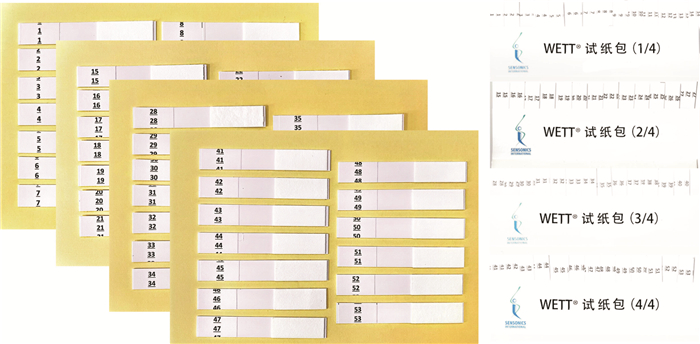
 下载:
下载:
